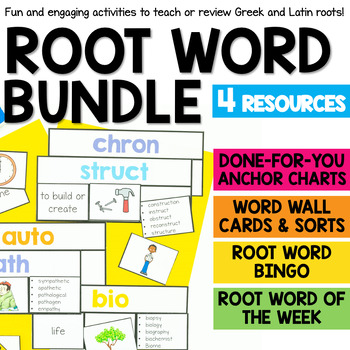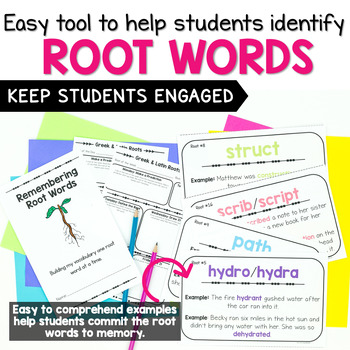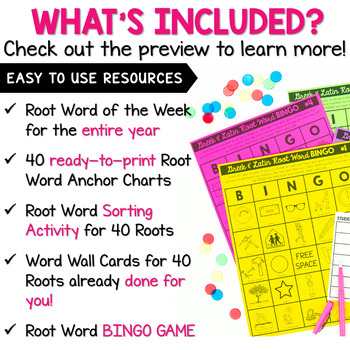Greek and Latin Roots: Root Word Activity Bundle
- Zip

What educators are saying
Products in this Bundle (4)
Description
Understanding root words is such an important part of word study. When students can identify and understand the meaning of common root words, they are equipped to build a robust vocabulary. Get four easy-to-use root word resources to help you teach 40 common Greek and Latin Root Words. This bundle includes a root word of the week routine, root word anchor charts, a BINGO game, and a sorting activity to make it easy for you to teach, practice, and review common Greek and Latin root words with your students.
Greek and Latin Root words are so important to teach in 3rd, 4th, and 5th grade. When students are familiar with common root words they quickly grow and improve their vocabulary. This will have a positive impact on reading and writing. With the resources in this bundle you’ll be able to easily focus on root words throughout the entire year.
THIS BUNDLE INCLUDES:
⭐️ Greek & Latin Root Word Sorts & Word Wall
⭐️ Greek and Latin Root Word Anchor Charts
⭐️ Greek and Latin Root Word BINGO Game
Each resource in this bundle includes the same 40 root words to make it easy for you to use all four resources in conjunction with each other.
WHAT ROOTS ARE COVERED IN THIS BUNDLE?
- astr/astro
- aud
- auto
- bio
- cent
- chron
- circum
- cred
- cycl
- dict
- flect/flex
- form
- frac/frag
- geo
- grad/gred
- graph/gram
- hydro/hydra
- ject
- jur/jud/jus
- liter
- mit/mis
- mem
- meter/metr
- path
- ped/pod
- phon
- photo
- port
- rupt
- scrib/script
- spec/spect
- struct
- tele
- ter/terra
- therm
- tra/tran/trans
- tract
- typ
- vac
- vis/vid
IDEAS FOR USING THESE RESOURCES IN YOUR CLASSROOM:
The root word of the week routine takes less than 5 minutes a day and works great as a bellringer or warm-up or to use as part of your morning meeting. Students love the consistency of the routine and really become confident with understanding roots.
The anchor charts work really well to introduce each root. You can give students a half-page version to glue in their journals and post the full-page versions on your reading bulletin board or focus wall.
The BINGO game and sort/word wall are great supplemental activities that make it easy to spiral and focus on root words throughout the entire year. Students love when they can explore root words with these hands-on activities.
HOW I USED THE WORD OF THE WEEK ROUTINE IN MY CLASSROOM:
My students loved using the word of the week routine to become familiar and confident with these root words. When I first introduced the routine we would spend 2-3 weeks doing it whole group, but eventually, my students became independent and the 5-minute routine is something they completed each day when they entered my classroom.
- Monday - Students will read the root of the week, predict what the root means and explain how the example sentences helped them make their prediction.
- Tuesday - Students will reference a dictionary or additional resource to identify the correct definition of the weekly root as well as identify the origin of the word.
- Wednesday - Students create an illustration or symbol that will help them remember what the root means.
- Thursday - Students go on a word hunt to find as many words as they can that contain the root of the week.
- Friday - Students will select 2-3 words from their list and use those words in sentences. This will give them an opportunity to display their understanding of the root.
TEACHERS LIKE YOU SAID…
⭐️⭐️⭐️⭐️⭐️ Sandra M. says, "I am using this to supplement morphology work with my reading intervention students. Thanks for doing all the prep for me!”
⭐️⭐️⭐️⭐️⭐️ Kaylee L. says, "This resource is helping my high flyers identify unknown words by chunking those known word pieces to determine the meaning using the context.”
⭐️⭐️⭐️⭐️⭐️ Kristin A. says, "My kiddos loved getting their "red folders" out to work on their roots. It was so exciting to see them make connections outside of class because of what they practiced with this resource. Thanks!”
___________________________________
YOU MAY ALSO LIKE…
→ Context Clue Activities & Worksheets for 3rd, 4th, and 5th Grade
→ Prefix and Suffix Word of the Week
_____________________________________
Copyright © The Stellar Teacher Co. LLC
www.stellarteacher.com
Permission to copy for single classroom use only.
Please purchase additional licenses if you intend to share this product.





